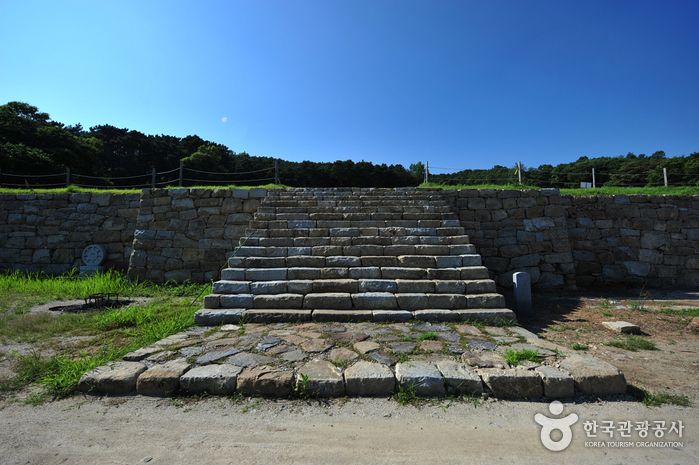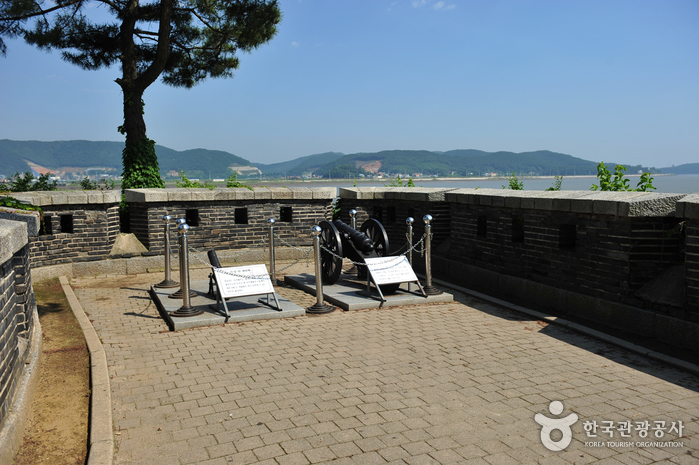Gimpo Munsusanseong Fortress (김포 문수산성)
7.4 Km 8216 2022-12-20
Ponae-ri, Gimpo-si, Gyeonggi-do
+82-31-980-2485
Munsusanseong Fortress was built on Munsusan Mountain in 1694, during the 20th year of the reign of King Sukjong, the 19th king of the Joseon dynasty. The fortress as designed to defend Gwanghwado Island from marine invasion. At the time, the fortress had north, west, and south gates, but they were destroyed in a fire during the Byeong-in Yangyo (1866). The north gate was restoryed in 1995 and the south gate in 2002. The fortress walls span 6 kilometers in length, 4 kilometers of which remain unrestored. Surrounded by beautiful scenery, the top of the fortress commands a spectacular view spanning from North Korea to the Hangang River inlet, and from Samgaksan Mountain to the sea off Incheon in the distance. It is often referred to as the Geumgangsan Mountain of Gimpo as it boasts superb scenery throughout all four seasons. The mountain is home to Munsusa Temple, established during the reign of Silla King Jinseong.
Olive Young - Gimpo Gurae Branch [Tax Refund Shop] (올리브영 김포구래)
7.9 Km 0 2024-04-18
21, Gimpohangang 9-ro 76beon-gil, Gimpo-si, Gyeonggi-do
-
Gimpo International Sculpture Park (김포국제조각공원)
7.9 Km 19934 2022-12-20
38, Yonggang-ro 13beon-gil, Gimpo-si, Gyeonggi-do
+82-31-984-5167
Gimpo Sculpture Park is situated in a large forest and is decorated with 30 sculptures: 14 by international artists and 16 by Korean artists. Since the site is located near the DMZ, the only divided country in the world, each sculpture expresses the overarching theme of unification. A favorite spot for weekend picnicking families and couples on dates, the park is expected to be included in a large tourist complex in the near future along with nearby Reports Park and the youth training center.
Gimpo Dodam Drugstore [Tax Refund Shop] (김포도담 드럭스토어)
8.0 Km 0 2024-04-22
71, Gimpohangang 7-ro, Gimpo-si, Gyeonggi-do
-
E-Mart - Gimpo Hangang Branch [Tax Refund Shop] (이마트 김포한강)
8.0 Km 0 2024-04-22
71, Gimpohangang 7-ro, Gimpo-si, Gyeonggi-do
-
Olive Young - Gimpo Gurae Station Branch [Tax Refund Shop] (올리브영 김포구래역)
8.1 Km 0 2024-04-23
2F Lotte Outlet Gwanggyo Branch, 10, Docheong-ro, Yeongtong-gu, Suwon-si, Gyeonggi-do
-
Ganghwa Seonwonsa Temple Site (강화 선원사지)
8.6 Km 12516 2022-09-19
222, Seonwonsaji-ro, Ganghwa-gun, Incheon
+82-32-933-8234
Ganghwa Seonwonsa Temple Site was first discovered in 1976 during a surface examination around Ganghwado Island undertaken by the Ganghwado Island Academic Research Team of Dongguk University. The site was designated as Historic Site No. 259 in 1977. Seonwonsa Temple was built by General Choi Wu in 1245 (the 32nd year of King Gojong’s reign during the Goryeo dynasty), which was right after the transfer of the capital to Ganghwado during resistance against the Mongolian invasion.
The temple was meant to be a spiritual mainstay in fighting against Mongolia. It used to be one of the two largest temples in Korea along with Songgwangsa Temple. However, the temple was completely destroyed during the early Joseon era, leaving only the site itself. The famous wood blocks of Palman Daejanggyeong (the Tripitaka Koreana), currently housed in Haeinsa Temple at Hapcheon, are said to have been originally stored in Seonwonsa Temple. It is believed that the carved wood blocks were taken from Seonwonsa to Heungcheonsa Temple during the Joseon era and again moved to Haeinsa Temple during the reign of Sejo.
Located on a mountain slope, the presumed location of the building site extends 250 meters from south to north and 170 meters from east to west.
Hamheodongcheon Campground (함허동천야영장)
8.8 Km 124030 2024-02-15
13 Haeannam-ro 1196beon-gil, Hwado-myeon, Ganghwa-gun, Incheon
032-930-7066
Hamheodongcheon Campground is a camping site nestled in the Hamheodongcheon valley on the northern slope of Manisan Mountain in Ganghwa-do, inaugurated in 1987. Enveloped by lush forests, it provides a picturesque setting and is especially favored as a summer retreat destination. The first campground accommodates electricity usage and operates through an internet reservation system, whereas the second to fourth campgrounds operate on a first-come, first-served basis without prior reservations.
Gapgotdon Watchtower (갑곶돈대)
9.4 Km 20624 2021-01-18
18, Haeandong-ro 1366beon-gil, Ganghwa-gun, Incheon
+82-32-930-7077
Gapgotdon Watchtower was built to protect the Ganghwa Straits from invasion when the Goryeo Kingdom moved their capital to Ganghwado Island. The fortified area served as a highly strategic location for the Goryeo Kingdom, and had endured multiple invasions by the Mongolian troops between 1232 and 1270.
The watchtower was fortified in the Joseon dynasty by King Sukjong in 1679 and had once fallen during the French campaign against Korea in 1866. In 1977, the site was restored to its original form. The cannons exhibited at the current site were made during the Joseon dynasty to attack outside invaders from sea.
[Ganghwa Nadeul-gil Course 2] Homeland Fortification Trail ([강화 나들길 제2코스] 호국돈대길)
9.4 Km 23046 2021-08-11
24, Cheonghadong-gil, Ganghwa-gun, Incheon
+82-32-934-1906
The Ganghwa Nadeul-gil Trails are a collection of walking paths along the coast of Ganghwa Island that connect the watchtowers and and walls of Ganghwasanseong Fortress, as well as royal tombs and other historically significant sites from the Goryeo dynasty that dot the island.
[Ganghwa Nadeul-gil Course 2] Homeland Fortification Trail
Course 2 stretches over a 17 kilometer area between Gapgotdon Watchtower and Chojijin Fort. This trail showcases the history of the island and the changes that happened before and after the opening of the port. The course follows a coastal road that is particularly beautiful in spring and fall.

![Olive Young - Gimpo Gurae Branch [Tax Refund Shop] (올리브영 김포구래)](http://tong.visitkorea.or.kr/cms/resource/04/2880504_image2_1.jpg)
![E-Mart - Gimpo Hangang Branch [Tax Refund Shop] (이마트 김포한강)](http://tong.visitkorea.or.kr/cms/resource/06/2880506_image2_1.jpg)
![Olive Young - Gimpo Gurae Station Branch [Tax Refund Shop] (올리브영 김포구래역)](http://tong.visitkorea.or.kr/cms/resource/01/2880501_image2_1.jpg)


![[Ganghwa Nadeul-gil Course 2] Homeland Fortification Trail ([강화 나들길 제2코스] 호국돈대길)](http://tong.visitkorea.or.kr/cms/resource/05/1895205_image2_1.jpg)
 English
English
 한국어
한국어 日本語
日本語 中文(简体)
中文(简体) Deutsch
Deutsch Français
Français Español
Español Русский
Русский